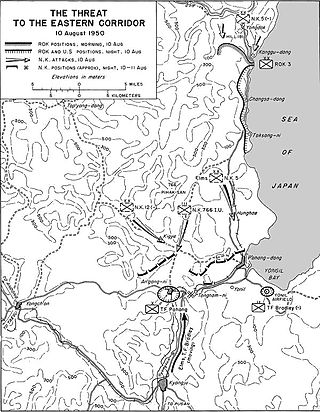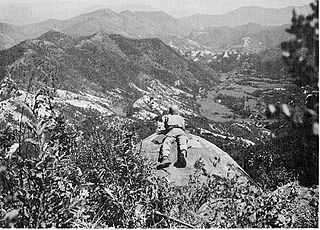
The Battle of Incheon, also spelled Battle of Inchon, was an amphibious invasion and a battle of the Korean War that resulted in a decisive victory and strategic reversal in favor of the United Nations Command (UN). The operation involved some 75,000 troops and 261 naval vessels and led to the recapture of the South Korean capital of Seoul two weeks later. The code name for the operation was Operation Chromite.

The Battle of the Pusan Perimeter was a large-scale battle between United Nations Command (UN) and North Korean forces lasting from August 4 to September 18, 1950. It was one of the first major engagements of the Korean War. An army of 140,000 UN troops, having been pushed to the brink of defeat, were rallied to make a final stand against the invading Korean People's Army (KPA), 98,000 men strong.

The 766th Independent Infantry Regiment was an elite light infantry unit of North Korea's Korean People's Army (KPA) that existed briefly during the Korean War. It was headquartered in Hoeryong, North Korea, and was also known as the 766th Unit. Trained extensively in amphibious warfare and unconventional warfare, the 766th Regiment was considered a commando unit. The regiment was trained to conduct assaults by sea and then to lead other North Korean units on offensive operations, to infiltrate behind enemy lines, and to disrupt enemy supplies and communications.

The Hadong Ambush was an engagement between United States and North Korean forces, occurring on July 27, 1950, in the village of Hadong in southern South Korea, early in the Korean War. The fight ended in a North Korean victory following a successful ambush of US forces which resulted in heavy American casualties.

The First Battle of Naktong Bulge was an engagement between United Nations Command (UN) and North Korean forces early in the Korean War from August 5–19, 1950 in the vicinity of Yongsan and the Naktong River in South Korea. It was a part of the Battle of Pusan Perimeter, and was one of several large engagements fought simultaneously. The battle ended in a victory for the UN after large numbers of US reinforcements destroyed an attacking North Korean division.

The Battle of P'ohang-dong was an engagement between the United Nations Command (UN) and North Korean forces early in the Korean War, with fighting continuing from 5–20 August 1950 around the town of P'ohang-dong, South Korea. It was a part of the Battle of Pusan Perimeter, and was one of several large engagements fought simultaneously. The battle ended in a victory for the UN after their forces were able to drive off an attempted offensive by three North Korean Korean People's Army (KPA) divisions in the mountainous eastern coast of the country.

The Battle of Taegu was an engagement between United Nations Command (UN) and North Korean forces early in the Korean War, with fighting continuing from August 5–20, 1950 around the city of Taegu, South Korea. It was a part of the Battle of Pusan Perimeter, and was one of several large engagements fought simultaneously. The battle ended in a victory for the UN after their forces were able to drive off an offensive by Korean People's Army (KPA) divisions attempting to cross the Naktong River and assault the city.

In the Battle of the Bowling Alley , United Nations Command (UN) forces defeated North Korean forces early in the Korean War near the city of Taegu, South Korea. The battle took place in a narrow valley, dubbed the "Bowling Alley", which was north of Taegu. It followed a week of fighting between the Korean People's Army (KPA) 13th Division and the Republic of Korea Army's (ROK) 1st Division along the latter's last defensible line in the hills north of the city. Reinforcements, including the US Army's 27th and 23rd Infantry Regiments were committed to bolster the ROK defenses. This battle and several others were smaller engagements of the Battle of Pusan Perimeter.
The Battle of Hwanggan was an engagement between United States and North Korean forces that took place on July 23–29, 1950, on a road north of the village of Hwanggan in southern South Korea, early in the Korean War. The battle ended in a victory for the North Koreans after US troops were forced to withdraw south.

The Battle of Masan was an engagement between United Nations Command (UN) and North Korean forces, which took place early in the Korean War between August 5 and September 19, 1950, in the vicinity of Masan and the Naktong River in South Korea. It was part of the Battle of Pusan Perimeter, and was one of several large engagements fought simultaneously. The battle ended in a victory for the UN after large numbers of United States Army (US) troops were able to repel the repeated attacks of two Korean People's Army (KPA) divisions.

The Battle of Battle Mountain was an engagement between United Nations Command (UN) and North Korean forces early in the Korean War from August 15 to September 19, 1950, on and around the Sobuk-san mountain area in South Korea. It was one of several large engagements fought simultaneously during the Battle of Pusan Perimeter. The battle ended in a victory for the UN after large numbers of United States Army (US) and Republic of Korea Army (ROK) troops were able to prevent a Korean People's Army (KPA) division from capturing the mountain area.

The Battle of Haman was one engagement in the larger Battle of Pusan Perimeter between United Nations Command (UN) and North Korean forces early in the Korean War from August 31 to September 19, 1950, in the vicinity of Haman County in South Korea. The engagement ended in a victory for the UN after large numbers of United States Army (US) and Republic of Korea Army (ROK) troops repelled a strong Korean People's Army (KPA) attack on the town of Haman.

The Battle of Nam River was an engagement between the United Nations Command (UN) and North Korean forces early in the Korean War from August 31 to September 19, 1950, in the vicinity of the Nam River and the Naktong River in South Korea. It was a part of the Battle of Pusan Perimeter, and was one of several large engagements fought simultaneously. The battle ended in a victory for the United Nations after United States Army (US) troops repelled a Korean People's Army (KPA). attack across the river.

The Great Naktong Offensive was a North Korean military offensive against United Nations Command (UN) forces early in the Korean War, taking place from September 1–15, 1950. It was the North Korean Korean People's Army (KPA)'s unsuccessful final bid to break the Pusan Perimeter established by the UN forces.

The Battle of Kyongju was an engagement between United Nations Command (UN) and North Korean forces early in the Korean War from August 31 to September 15, 1950, in the vicinity of Kyongju in South Korea. It was a part of the Battle of Pusan Perimeter, and was one of several large engagements fought simultaneously. The battle ended in a victory for the UN after large numbers of United States Army (US) and Republic of Korea Army (ROK) troops repelled a strong North Korean Korean People's Army (KPA) attack.

The Battle of Tabu-dong was an engagement between United Nations Command (UN) and North Korean forces early in the Korean War from 3 to 29 August 1950, in the vicinity of Tabu-dong, north of Taegu in South Korea. It was a part of the Battle of Pusan Perimeter, and was one of several large engagements fought simultaneously. The battle ended in a victory for the UN after large numbers of United States Army (US) and Republic of Korea Army (ROK) troops repelled a strong Korean People's Army (KPA) attack.

The Battle of Ka-san was an engagement between United Nations Command (UN) and North Korean forces early in the Korean War from September 1 to September 15, 1950, in the vicinity of Ka-san in South Korea. It was a part of the Battle of Pusan Perimeter, and was one of several large engagements fought simultaneously. The battle ended in a victory for the United Nations after large numbers of United States Army (US) and Republic of Korea Army (ROK) troops repelled a strong Korean People's Army (KPA) attack.

The Second Battle of Naktong Bulge was an engagement between United Nations Command (UN) and North Korean forces early in the Korean War from September 1 to September 15, 1950, along the Naktong River in South Korea. It was a part of the Battle of Pusan Perimeter, and was one of several large engagements fought simultaneously. The battle ended in a victory for the United Nations after large numbers of United States Army (US) troops repelled a strong Korean People's Army (KPA) attack.

The Battle of Yongsan was an engagement between United Nations Command (UN) and North Korean forces early in the Korean War from September 1–5, 1950, at Yongsan in South Korea. It was part of the Battle of Pusan Perimeter and was one of several large engagements fought simultaneously. The battle ended in a victory for the UN after large numbers of United States Army (US) repelled a strong Korean People's Army (KPA) attack.
The Bloody Gulch massacre was a war crime that took place in the Korean War on August 12, 1950, in "Bloody Gulch", west of Masan, South Korea. After a very successful attack on two undefended US artillery battalions that killed or injured hundreds of US soldiers, members of North Korea's Korean People's Army (KPA) 13th Regiment murdered seventy-five captured US Army prisoners of war during one of the smaller engagements of the Battle of Pusan Perimeter. The murdered soldiers were from the 555th Field Artillery Battalion of the US 24th Infantry Division and the 90th Field Artillery Battalion of the US 25th Infantry Division.



















